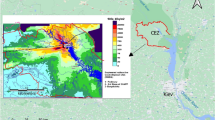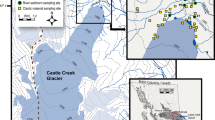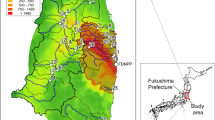Abstract
Three Mile Island (TMI) and Peach Bottom (PB) reactors have introduced 137Cs, 134Cs, 60Co, 58Co and several other anthropogenic radionuclides into the lower Susquehanna River. Here we present the release history for these nuclides (Table 1) and radionuclide concentration data (Table 2) for sediment samples collected in the river and upper portions of the Chesapeake Bay (Fig. 1) within a few months after the 28 March 1979 loss-of-coolant-water problem at TMI. Although we found no evidence for nuclides characteristic of a ruptured fuel element, we did find nuclides characteristic of routine operations. Despite the TMI incident, more than 95% of the total 134Cs input to the Susquehanna has been a result of controlled low-level releases from the PB site. 134Cs activity released into the river is effectively trapped by sediments with the major zones of reactor-nuclide accumulation behind Conowingo Dam and in the upper portions of Chesapeake Bay. The reported distributions document the fate of reactor-released radionuclides and their extent of environmental contamination in the Susquehanna–Upper Chesapeake Bay System.
This is a preview of subscription content, access via your institution
Access options
Subscribe to this journal
Receive 51 print issues and online access
$199.00 per year
only $3.90 per issue
Buy this article
- Purchase on Springer Link
- Instant access to full article PDF
Prices may be subject to local taxes which are calculated during checkout
Similar content being viewed by others
References
Donoghue, J. F. et al. Proc. & Abstr. Middle Atlantic Regional Meet of Am. chem. Soc. 74 (1980).
Reil, G. K. Radiat. Hlth Data Rep. 11, 659–665 (1970).
Aston, S. R. & Stanners, D. A. Estuar. Coast. mar. Sci. 9, 529–541 (1979).
Hetherington, J. A. & Jefferies, D. F. Neth. J. Sea Res. 8, 319–338 (1974).
Simpson, H. J., Olsen, C. R., Williams, S. C. & Trier, R. M. Science 194, 179–183 (1976).
Olsen, C. R. et al. J. Sed. Petrol. 48, 401–418 (1978).
Olsen, C. R. thesis, Columbia Univ. (1979).
Perkins, R. W., Nelson, J. L. & Haushild, W. L. Limnol. Oceanogr. 11, 235–248 (1966).
Gross, M. G. J. geophys. Res. 71, 2071–2021 (1966).
Cutshall, N. H., Larsen, I. L. & Nichols, M. Science 213, 440–442 (1981).
Cressy, P. J. NASA Tech. Note D-8169 (NASA, Washington DC, 1979).
Hirschberg, D. J. & Schubel, J. R. Estuar. Coast. mar. Sci. 9, 771–784 (1979).
Goldberg, E. D. et al. Geochim. cosmochim. Acta 42, 1413–1425 (1978).
Gross, M. G., Karweit, M., Cronin, W. B. & Schubel, J. R. Estuaries 1, 106–110 (1978).
Bopp, R. F., Simpson, H. J., Olsen, C. R. & Kostyk, N. Envir. Sci. Technol. 15, 210–216 (1981).
Donoghue, J. F. thesis, Univ. South California (1981).
Author information
Authors and Affiliations
Rights and permissions
About this article
Cite this article
Olsen, C., Larsen, I., Cutshall, N. et al. Reactor-released radionuclides in Susquehanna River sediments. Nature 294, 242–245 (1981). https://doi.org/10.1038/294242a0
Received:
Accepted:
Issue Date:
DOI: https://doi.org/10.1038/294242a0
Comments
By submitting a comment you agree to abide by our Terms and Community Guidelines. If you find something abusive or that does not comply with our terms or guidelines please flag it as inappropriate.



